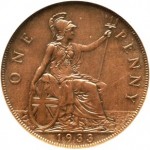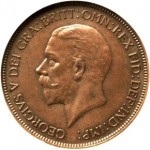Britain's Famous 1933 Penny Sets Record
 Reverse of 1933 George V penny (Heritage Auctions
Reverse of 1933 George V penny (Heritage AuctionsWhile Americans think of the Saint Gaudens double eagle gold coins when "rare 1933 coin" is mentioned, British coin enthusiasts immediately picture a vastly different coin in their minds: The 1933 George V penny.
Considered the rarest British coin of the 20th Century, only seven 1933 George V pennies are known to exist. As you can imagine, one comes up for sale only once in a generation. One of the seven 1933 British pennies sold this month recently sold for $165,000 in a Heritage auction ($193,875 including17.5% buyer's premium). This set a new world's record for a copper or bronze coin sold at auction.
Of course, the first question people ask when they learn of the 1933 George V penny is, "Why did the Royal Mint only make seven pennies in 1993?
In 1933, the United Kingdom was solidly in the throes of the Great Depression. Banks already had more than enough pennies on-hand, so the Royal Mint made no provisions for minting additional "coppers" that year. (None were produced from 1923 through 1925 either, coincidentally.)
 Obverse of 1933 George V penny (Heritage Auctions
Obverse of 1933 George V penny (Heritage AuctionsLater, the Mint was approached by representatives of the King. They requested a few 1933 British pennies be struck so that complete 1933 coin sets could be assembled. These coin sets were personally placed by King George V into the cornerstones of high-profile buildings that were beginning construction that year. A total of only seven 1933 George V pennies are known to have been struck.
Of these seven coins, one is in the British Museum, one in the Royal Mint Museum, and one remains in the cornerstone of the University of London building in Bloomsbury, London. One was stolen from the cornerstone of the Church of St. Cross in Middleton during renovations in 1970. It has never been seen again. After the theft at St. Cross, the Bishop of Ripon ordered the 1933 penny in the cornerstone of St. Mary's Church in Leeds be removed to avoid a similar desecration. The entire 1933 coin was placed in auction at Sotheby's in 1972, fetching £7,000. The remaining two have been in private hands, presumably since 1933.
It was one of these last two coins that sold this month for a record price, with a sterling provenance. This mint state 1933 George V penny was acquired from the famous Norweb Collection. The late Henry and Emery Norweb assembled one of the world's great coin collections during their lives. This particular coin can trace its provenance from Emery Norweb to PG Smith to the great Laurie Asher Lawrence.
Wishful Thinking
This month's record-setting sale of a 1933 George V penny brings back memories of the old urban legend prior to decimalization, that there were 1933 pennies that had accidentally been placed in circulation. This myth gained traction in the years immediately after World War II. Many buildings in London had been destroyed by Nazi bombers during the "Blitz," and it was fancied that someone may have found an exposed cornerstone from 1933 with the coin set inside. The speculation was that, if it really happened, the penny was likely spent (with the rest of the coins) on food or clothing and entered circulation.
So far, this has proven to be wishful thinking. With the change of UK coinage to a decimal currency in 1971, there are no old pennies in circulation at all. Maybe the dream will come true for someone sorting through their grandpa's old coins, but it's nothing to bank on.
The opinions and forecasts herein are provided solely for informational purposes, and should not be used or construed as an offer, solicitation, or recommendation to buy or sell any product.

Steven Cochran
A published writer, Steven's coverage of precious metals goes beyond the daily news to explain how ancillary factors affect the market.
Steven specializes in market analysis with an emphasis on stocks, corporate bonds, and government debt.
